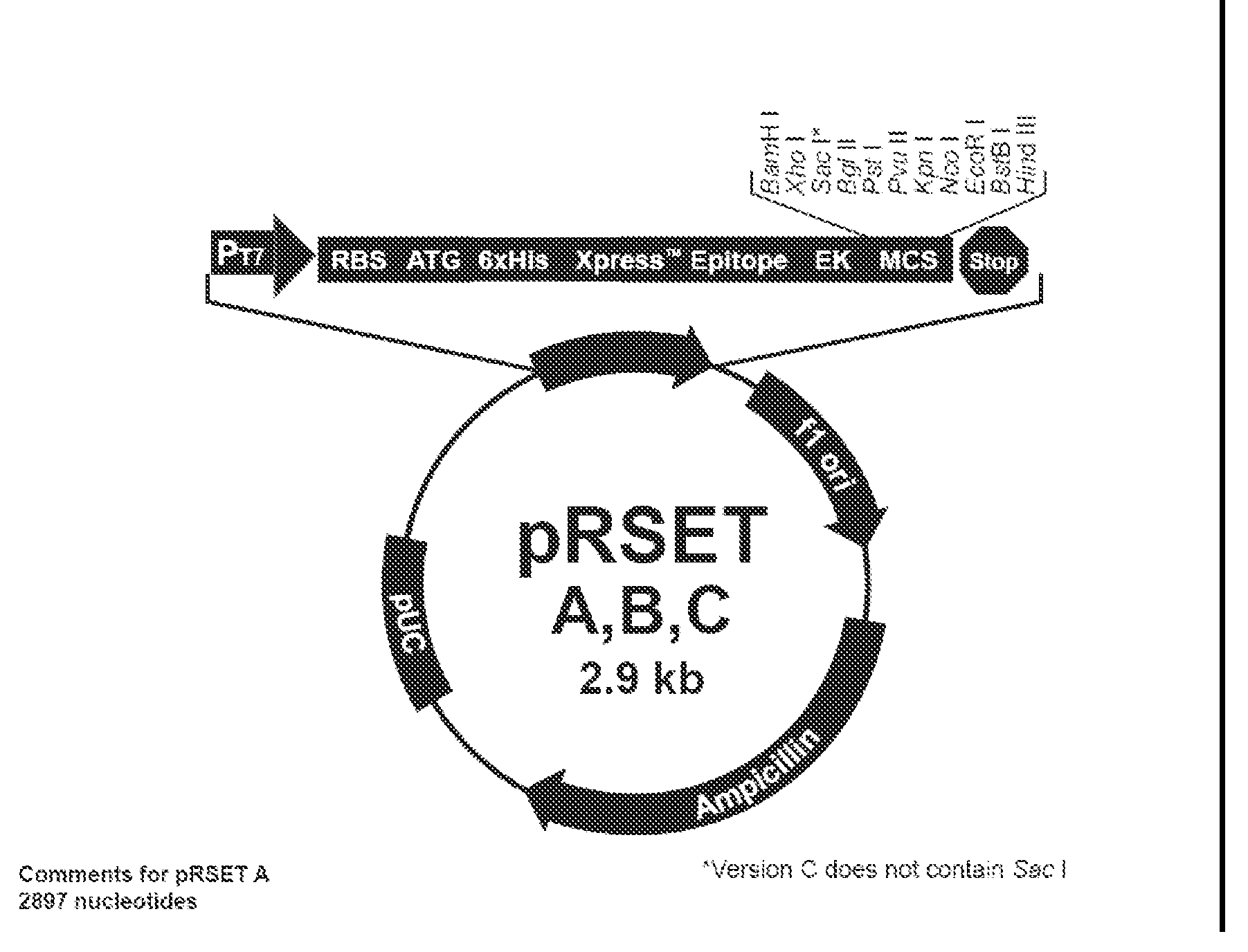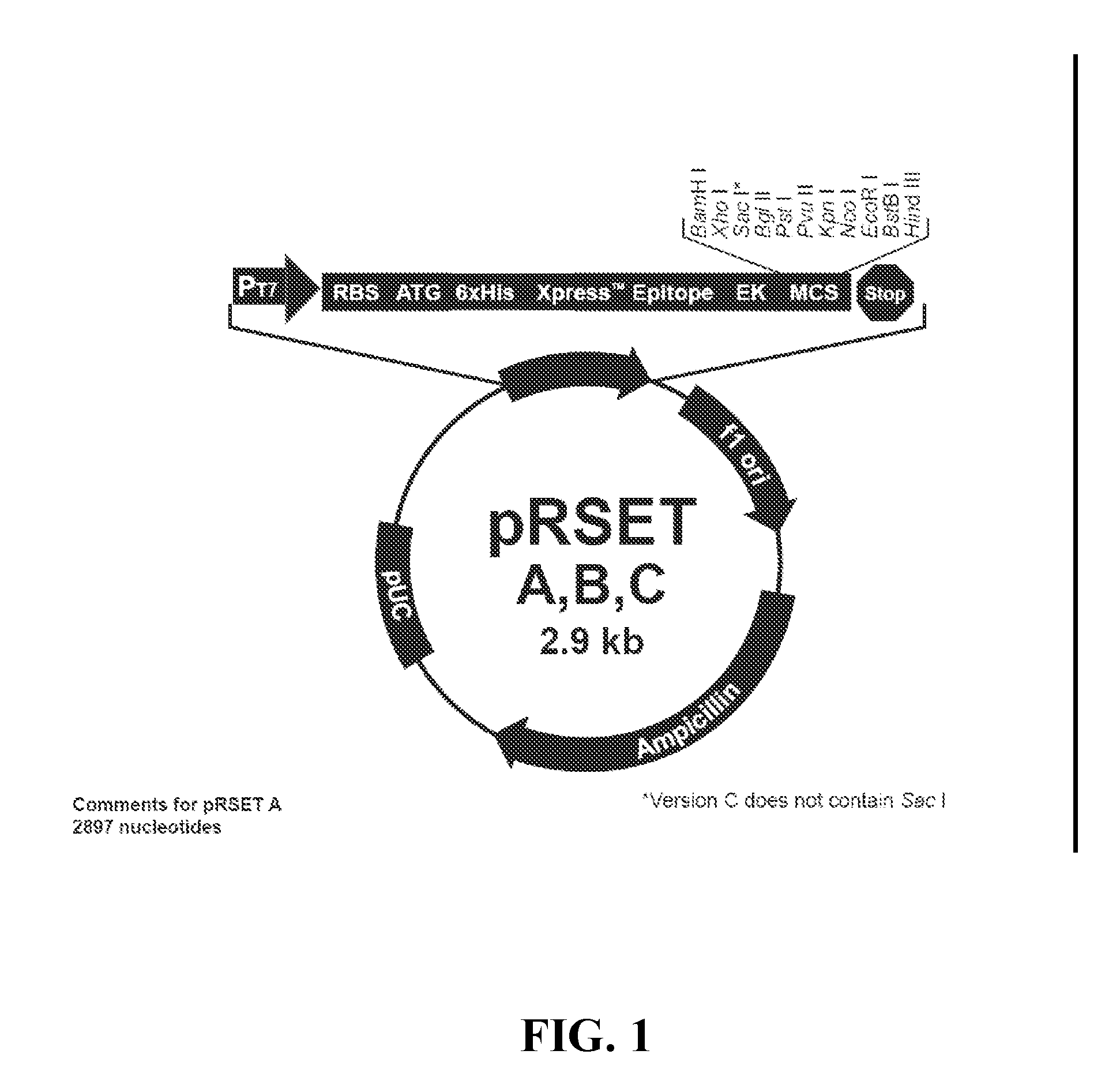Novel Fusion Carbonic Anhydrase/Cellulose Binding Polypeptide Encoded by a Novel Hybrid Gene, and Method of Creating and Using the Same
a technology of cellulose binding and carbonic anhydrase, which is applied in the field of new fusion carbonic anhydrase/cellulose binding polypeptide encoded by a novel hybrid gene, can solve the problems of high cost of enzyme immobilization, waste management of spent scrubber solution, and difficulty in operation and maintenance,
- Summary
- Abstract
- Description
- Claims
- Application Information
AI Technical Summary
Benefits of technology
Problems solved by technology
Method used
Image
Examples
example i
PCR Amplification and Purification of CA DNA
[0098]N. gonorrhoeae genomic CA DNA was obtained from ATTC (ATTC No. 53422D; SEQ ID NO: 10) and used as a target for PCR reactions to amplify the CA DNA. The DNA used encodes a mature carbonic anhydrase which lacks 25 amino acids of signal peptide. Although a number of CAs may be employed, mature CA DNA was found to produce a hybrid CA-CBD protein that was much easier to refold and avoided inclusion body problems encountered with the use of several other CA constructs.
[0099]The PCR primers shown in Table I were designed to provide specific-restriction sites at the ends so that the amplified product could be cloned directly into the vector plasmid into plasmid pRSET-B. The plasmid carrying an integrated CA is referred to as R1.
TABLE IPrimers for PCR of CADNA Sequence:RestrictionPrimerF / RTarget5′ to 3′ntSiteCAfFCAATTTGCAGATCTCAC30Bgl IIGGCAATCACACCCASEQ ID NO. 5CarRCAACGGccatggTTATT29Nco ICAATAACTACACGTSEQ ID NO. 6
[0100]PCR amplification was...
example ii
Construction of Plasmid R2 Carrying CA-CBD Fusion
[0103]DNA from Clostridium thermocellum was obtained from ATTC (ATTC No. 27405D) and used as a target for PCR reactions to amplify the CBD gene. The PCR primers shown in Table II. PCR amplification was achieved by incubating the PCR reaction mixture in a thermal cycler at 94° C. for 5 min to completely denature the template and activate the enzyme. Performed 30 cycles of PCR amplification as follows: Denature at 94° C. for 30 sec, anneal at 50° C. for 30 sec, extend at 72° C. for 1 min followed by an additional extension at 72° C. for 10 min. The content was kept at 4° C. A detailed RT-PCR protocol is further explained in Sambrook, Molecular Cloning: A Laboratory Manual, Second Edition, Cold Spring Harbor Laboratory Press, Cold Spring Harbor, N.Y.; DNA Cloning: A practical Approach.
[0104]The amplified CBD DNA were digested by Bam HI / Bgl II and then ligated to Plasmid pRSET-R1 which was also digested with the same enzymes to create pla...
example iii
Identification of CBD-CA
[0109]The ligated-CBD-CA fusion was used to transform competent E. coli cells which were placed in LB medium containing 50 ug / ml ampicillin. A colony was selected and the recombinant plasmid R2 carrying the CA-CBD fusion was identified by PCR, enzyme digestion and DNA sequencing. The clones were selected from the relevant antibiotic plates. The plasmid was extracted and the enzyme digestion was performed for the selection of the positive according to the size of insert. The PCR amplification was also used for the selection according to the size of amplified PCR product and the product was sequenced. DNA Sequence was performed by Sanger sequencing method.
[0110]The DNA sequence for the CBD-CA was determined to the sequence in SEQ ID NO: 1 encoding the amino acid sequence SEQ ID NO: 8.
Example IV Transformation of E. coli Host and Expression of Host Protein
[0111]The recombinant vector R2 containing CBD and CA was transformed to BL21 (DE3) pLysS as the host strain...
PUM
| Property | Measurement | Unit |
|---|---|---|
| Fraction | aaaaa | aaaaa |
| Fraction | aaaaa | aaaaa |
| Greenhouse gas emission | aaaaa | aaaaa |
Abstract
Description
Claims
Application Information
 Login to View More
Login to View More - R&D
- Intellectual Property
- Life Sciences
- Materials
- Tech Scout
- Unparalleled Data Quality
- Higher Quality Content
- 60% Fewer Hallucinations
Browse by: Latest US Patents, China's latest patents, Technical Efficacy Thesaurus, Application Domain, Technology Topic, Popular Technical Reports.
© 2025 PatSnap. All rights reserved.Legal|Privacy policy|Modern Slavery Act Transparency Statement|Sitemap|About US| Contact US: help@patsnap.com



